Elsa did some modest nudity in One on Top of the Other (1969). This is the first time it has been available in Blu-Ray quality.
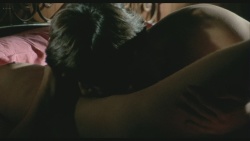
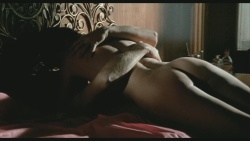
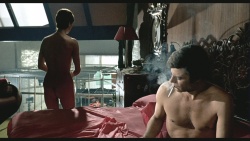
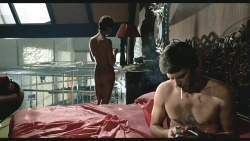
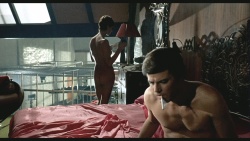
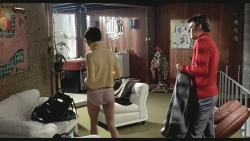
Elsa was modest in her film appearances. Apart from this scene, her only film nudity was a very brief bit in Les Chemins de Katmandou (1969). Although she seemed to avoid any explicit film nudity, she later posed for a completely naked photoshoot for a 1975 men’s magazine.
As for the movie:
One on Top of the Other, aka Una sull’altra, aka Perversion Story, is a 1969 Italian giallo film directed by Lucio Fulci, involving a frame-up for murder – of a woman who isn’t dead. To me it seems like a typically cheesy Italian film from the late 60s and early 70s, but IMDb voters seem to like it a lot, scoring it a very respectable 6.7. That’s as good as or better than some “Best Picture” winners like Gigi, Tom Jones and the Greatest Show on Earth, not to mention several others from the 1930s.
Complete diversion:
1963 was an odd year. To modern viewers, the selection of Tom Jones seems inexplicable, except for the fact that Hollywood was going through an Anglophile phase. First of all, Tom Jones has the lowest IMDb rating of the nominees:
Tom Jones 6.5
America America 7.8
Cleopatra 7.0
Lilies of the Field 7.6
How The West Was Won 7.1
That’s not quite as baffling as the fact that Tom Jones doesn’t even seem to belong among the nominees. Some of the most memorable films from that year were not even nominated. Among the films that have stood the test of time: The Great Escape (8.2), Charade (7.9), The Birds (7.7), Hud (7.8), and a slew of great foreign films. If the academy’s current voters could get a do-over on 1963, I feel that The Great Escape would win the Best Picture Oscar.
But my arguments are oversimplified. Tom Jones seemed a lot better in 1963 than it does today. The film techniques used in Tom Jones were fresh at the time, but the film was popular enough that it inaugurated a certain style of filmmaking that soon became hackneyed:
– the bedroom and countryside romps in speeded-up motion, accompanied by harpsichord music
– the characters looking in the camera and mugging for the audience
– the narration
That style has been copied so often in the intervening years, that Tom Jones seems like a cliché when watched today. It’s like watching a painfully unfunny episode of Benny Hill. So the IMDb score is indicative of our modern perspective. We view it as tired, trite and dated.
But it did not seem to be in 1963.
TRIVIA: John F. Kennedy watched Tom Jones on Nov 17, 1963. It was the last film he ever saw. He was assassinated five days later.


btw, how did Amadeus (1984) win best picture or even get nominated? Inquiring minds …
Getting back to the subject of this post, Ms. Martinelli, in this post, above the sentence that introduces the naked pic of her lying down on the couch (or bed), there is a big BLANK box. Nothing there, except in the upper right corner of said box there are a couple of what looks like html symbols.
What is supposed to be there? In other words, what am I missing?
It was an embedded clip from Les Chemins de Katmandou. It was working when I posted it, but subsequently crapped out. I removed the code.
Why “The Greatest Show on Earth”? Look at the box office for that year.
1 The Greatest Show on Earth $60,000,000
2 The Snows of Kilimanjaro $21,555,671
3 High Noon $13,333,333
4 The Quiet Man $12,666,666
5 Singin’ in the Rain $11,873,891
6 The World in His Arms $5,000,000
7 Million Dollar Mermaid $4,583,333
8 Invasion, U.S.A. $2,000,000
9 Snow White and the Seven Dwarfs $1,833,333
Why did everybody like a film then that people don’t like now? Because that was then and this is now. Obviously people loved the film then. People also loved the Circus. Tastes change.
Box Office has nothing to do with Oscars, hence no Oscars for Three Men and a Baby and How the Grinch Stole Christmas. It is easy to understand why movies like Three Men and The Greatest Show on Earth were popular. The challenge is to explain why such a movie was honored.
I can tell from your comments that you haven’t seen the movie. I’m pretty sure that if you had, you would not have the same feelings. It is just awful. As a documentary about the circus, it would have been and still is interesting, and the train wreck was an incredible scene to pull off with 1952 technology, but it’s not a documentary. It is a fictional film with a plot, and if you watch it you may find yourself looking away in embarrassment from several scenes. That, however, was commonplace in the 50s. The same could be said of Three Coins in a Fountain and Love Is a Many-Splendored Thing, two Best Picture nominees from the era. As you noted, our standards change with the times, and the 50s seemed to have a soft spot, or maybe I should say a blind spot, for schmaltz and hokum.
It was a popular film because, as you note, people like hokum and they used to like circuses. And popular it was. The film was not only loved by everyday movie-goers, many of whom went to see it again and again, but it was also received reasonably well by critics, who were absolutely dazzled by the spectacle, the effects and the “technicolor.”
My favorite line in a review was in the NY Daily News: “Charlton Heston, a TV actor who has been in only a few films, comes through.” Talk about seeing the film through the eyes of 1952! Who today, when hearing the name Charlton Heston, thinks “oh, yeah, that TV actor”?
Interesting Sean Aloysius Kilmartin O’Feeney er John Ford won best director (Quiet Man) over Cecil B. Demille which almost never happened back then ie best director was almost always the director of best film oscar winner.
Indeed, back in the day when you heard who best editor was you knew that film was also winning best director and best film.
Digressing …
Also interesting C.B. never won best director. 😮 Re: a cast of thousands ~ less is more lol …
The Greatest Show on Earth is the perfect example of why you can’t judge a film by today’s morays and opinions. It was far and away the top grossing film that year. Hugely popular. Why? It is a spectacular film made by one of the best film makers ever. It’s about the circus, which today has a terrible reputation, but then was very popular and part of the culture. If you can’t understand why a film about the circus would be a big deal you have no sense of history.
Or a simple easy to watch crowd pleaser made a predictably large amount of money.
That doesn’t make it a great movie. The Oscars are never about what makes the most money. None of the Transformers movies have gotten a nomination. By your standards they’ve should’ve been a lock.
I usually consult a moray before watching a film. And centipedes are quite the bookworms.
Yeah trust me on this, if you’re new in town, haven’t made friends yet, but you’re looking for a good ska show, ask any Thompson’s gazelle. They always know.
In regards to Tom Jones, it’s not unusual for the Oscars to make a bad selection among the nominees.
In regards to Elsa Martinelli, she’s a lady.
Seriously though, it really isn’t unusual for the Oscars to have a bad selection among the nominees for best picture.
I’d have to think the worst is The Towering Inferno.
The Towering Inferno was bad, but it was a Best Picture nominee, not a winner. And when it comes to bad nominees, remember that Doctor Doolittle was nominated as Best Picture.
Not to mention:
Three Coins in a Fountain
Love Is a Many-Splendored Thing
The Greatest Show on Earth (which won!!!)
Airport
The Alamo
Thoughts about 1952 movies: I have never been able to figure out what they were thinking of back in the post-war years. The Greatest Show on Earth? Really?
Singin’ in the Rain, one of the greatest movies ever made (8.3 IMDb, 99 Metascore, 100% Rotten Tomatoes), came out the same year – not even a nomination. That one is utterly baffling. As Roger Ebert wrote, “The verdict of the years knows better than Oscar: Singin’ In The Rain is a transcendent experience, and no-one who loves movies can afford to miss it.”
Chaplin’s Limelight (8.1 IMDb, 97% Rotten Tomatoes) also came out that year – no nomination.
Per Wikipedia, concerning The Greatest Show on Earth:
“Many consider this film among the worst to have ever won the Academy Award for Best Picture. It also won that award over highly rated films such as High Noon, The Quiet Man, Ivanhoe and the non-nominated Singin’ in the Rain. The American film magazine Premiere placed the movie on its list of the 10 worst Oscar winners and the British film magazine Empire rated it #3 on their list of the 10 worst Oscar winners. It has the second lowest spot on Rotten Tomatoes’ list of the 90 films to win Best Picture.
Stanley Kramer alleged that the film’s Best Picture Oscar was due to the political climate in Hollywood in 1952. Senator Joseph McCarthy was pursuing Communists at the time, and (Director) DeMille was a conservative Republican involved with the National Committee for a Free Europe. Another Best Picture nominee, High Noon, was produced by Carl Foreman, who would soon be on the Hollywood blacklist, and one of the scriptwriters of Ivanhoe, Marguerite Roberts, was also blacklisted.”
Per me:
The political climate would also explain why Limelight wasn’t nominated. Chaplin’s politics were considered to be somewhere left of Trotsky’s.
I don’t know that much about Chaplin, but I think his reputation as a lefty is as overstated as just about anybody’s the GOP calls a “radical socialist” today. I can always be wrong, but “Communist” was just what you got called in the 40’s and 50’s if Daughters of the American Revolution didn’t approve of you.
What you are saying is accurate, but not from the viewpoint of 1953. He was considered to be a radical leftist. My original point was that he could not be nominated in 1952-53 because of his politics, and I think that is certainly correct – obviously as his beliefs were perceived then, not as we view them now.
In October, 1942 Chaplin was the main speaker at a Communist-backed Artists Front to Win the War event in Carnegie Hall. He addressed the crowd as “comrades” and said that Communists are “ordinary people like ourselves who love beauty, who love life. They say Communism may spread out all over the world. And I say – so what?” Needless to say, these words did not sit well with the likes of J. Edgar, and were to haunt Chaplin through the decades.
Once again, thanks for alleviating my ignorance, UncleScoopy. And also making me realize that I should read more carefully to understand what people are actually saying. But it is just so much more fun to talk than to listen and think!
BTW, October 1942 was about a year and a quarter after Hitler invaded the Soviet Union, and about 10 months after Pearl Harbor. A lot of people were saying nice things about the Russian people then, although of course most of them did not praise Communism as well.
As my dad always reminded me, many Americans felt we should have entered the war in Europe earlier – on the other side! Even then, the American right was using the word “socialist” in their favorite scary bedtime story, the one about the evil Bugbear of Communism hiding in America’s closet, waiting to ensnare our children.